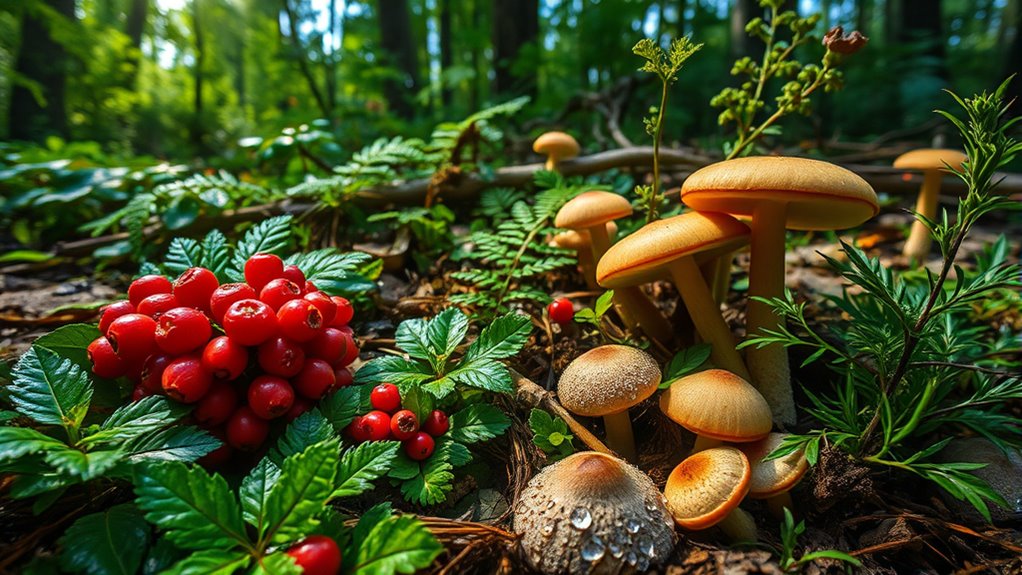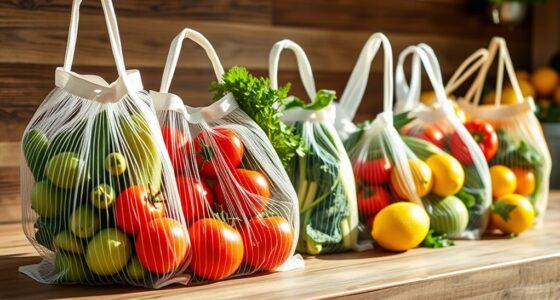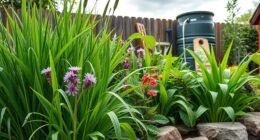If you’re looking for the best North American foraging guides, I recommend a mix of detailed field guides, mushroom-specific books, and regional resources. I focus on those featuring clear visuals, safety tips, and regional coverage to help you confidently identify wild edibles and avoid toxins. Top picks include guides on edible plants, mushrooms, medicinal herbs, and poisonous species. Keep exploring further, and you’ll discover even more valuable tools for your foraging adventures.
Key Takeaways
- Look for guides with detailed photos and illustrations of North American wild edibles, including identification features and look-alike warnings.
- Prioritize comprehensive books covering various ecosystems, regional plants, and safe harvesting practices for confident foraging.
- Choose durable, waterproof guides suitable for outdoor use, especially those with clear organization and easy-to-navigate content.
- Consider guides that include edibility, preparation tips, and toxic plant warnings to ensure safe consumption.
- Explore specialized resources on mushrooms, regional flora, and poisonous plants for a well-rounded foraging reference.
Edible Wild Plants: A North American Field Guide to Over 200 Natural Foods
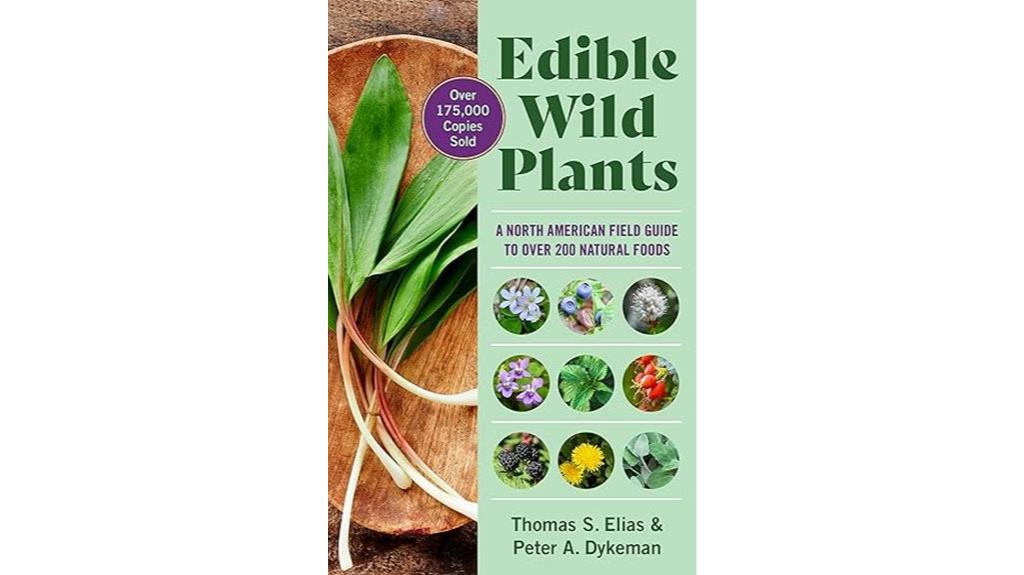
If you’re serious about foraging in North America, “Edible Wild Plants: A North American Field Guide to Over 200 Natural Foods” is an essential resource. I’ve found it incredibly helpful for identifying and understanding wild plants, thanks to its detailed descriptions, photos, and seasonal organization. It covers a wide range of species across the continent, making it useful whether you’re hiking or camping. While some images are black and white, the guide’s practical advice on harvesting and preparing plants makes it invaluable. It’s a must-have for outdoor enthusiasts, survivalists, and herbalists looking to expand their knowledge safely and confidently.
Best For: outdoor enthusiasts, survivalists, herbalists, and hikers seeking a comprehensive guide to identifying and using wild edible plants across North America.
Pros:
- Offers detailed descriptions, photos, and seasonal organization for easy plant identification.
- Covers a wide range of species across North America, making it versatile for various regions.
- Includes practical advice on harvesting and preparing wild plants, enhancing safe foraging practices.
Cons:
- Contains some black-and-white images that can hinder accurate plant recognition.
- The broad geographic scope may limit usefulness for localized foraging needs.
- Organization based on seasons can be helpful but might lack detailed regional distinctions.
Peterson Field Guide to Mushrooms of North America, Second Edition
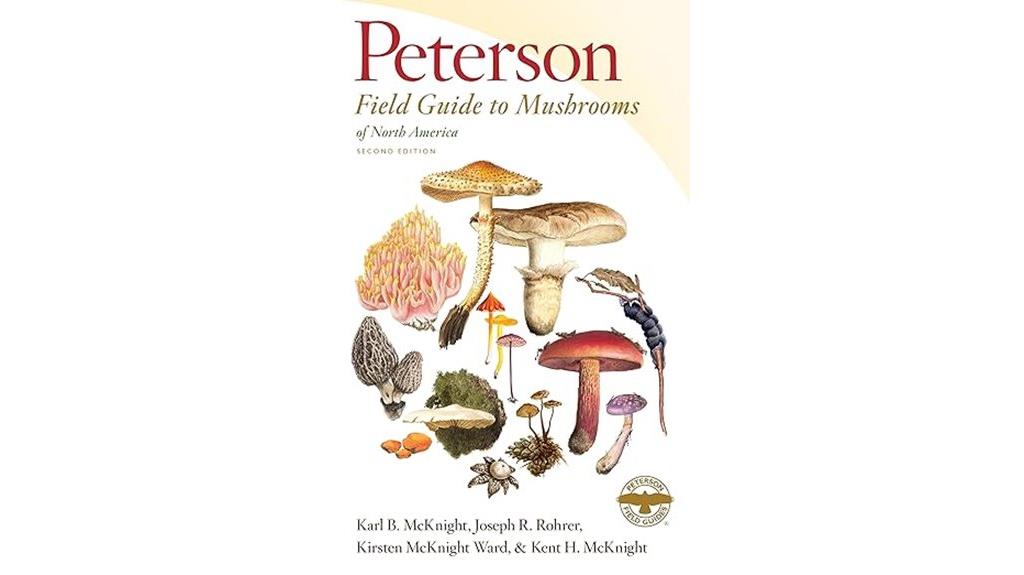
The Peterson Field Guide to Mushrooms of North America, Second Edition stands out as an excellent choice for beginners and casual foragers because of its clear layout, vivid photos, and practical identification tips. I appreciate how it’s designed for outdoor use, with detailed illustrations organized by mushroom structure and a helpful flowchart to guide identification. The high-quality artwork, especially from Vera McKnight, makes recognizing species like Toad Stools and False Morels easier. It emphasizes safety with notes to avoid misidentification. Compact and portable, it’s perfect for mushroom hunting trips, offering a thorough, accessible resource for both novices and seasoned mycologists.
Best For: beginner and casual mushroom foragers seeking a clear, visual, and practical guide for outdoor mushroom identification.
Pros:
- Features vivid, high-quality illustrations organized by mushroom structure for easy recognition
- Compact and portable design ideal for outdoor use and mushroom hunting trips
- Emphasizes safety with notes to help prevent misidentification and potential hazards
Cons:
- Limited to North American species, reducing usefulness for international foragers
- Some outdated common names and omitted classic artwork from earlier editions
- Not suitable for identifying mushrooms requiring microscopic or chemical analysis
Guide to Foraging North American Mushrooms
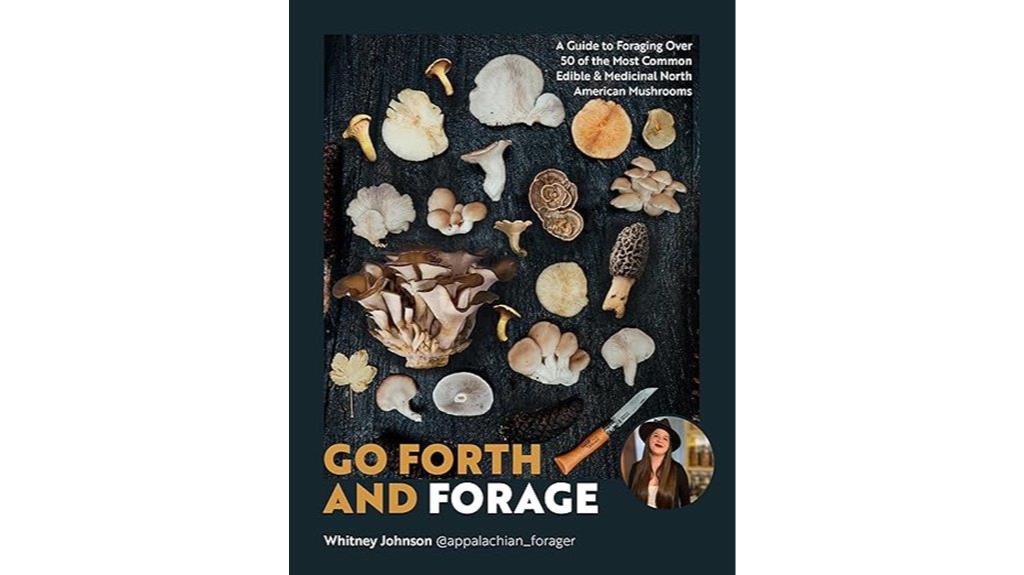
Foraging North American mushrooms becomes much less intimidating with Whitney Johnson’s “Go Forth and Forage,” especially since it’s designed to boost confidence for both beginners and experienced foragers. This guide covers over 50 common edible and medicinal mushrooms, offering clear photos, straightforward descriptions, and practical recipes. Whitney’s engaging, humorous style makes learning enjoyable, while her expert knowledge guarantees accuracy. The book’s portable size, sturdy construction, and helpful features like QR codes make it perfect for outdoor use. Whether you’re starting out or refining your skills, this guide simplifies identification and encourages safe, successful mushroom hunting in North America.
Best For: beginners and experienced foragers seeking a reliable, engaging, and practical guide to identifying and using North American mushrooms safely and confidently.
Pros:
- Accurate identification with vivid, easy-to-spot photographs and clear descriptions
- User-friendly layout with helpful tips, QR codes, and practical recipes
- Portable, sturdy design perfect for outdoor foraging adventures
Cons:
- Focuses mainly on over 50 common mushrooms, which may omit some less common species
- Not a comprehensive mushroom foraging encyclopedia for all regions or rare varieties
- Some users may desire more in-depth scientific details or advanced foraging techniques
The Foragers Harvest: Guide to Edible Wild Plants
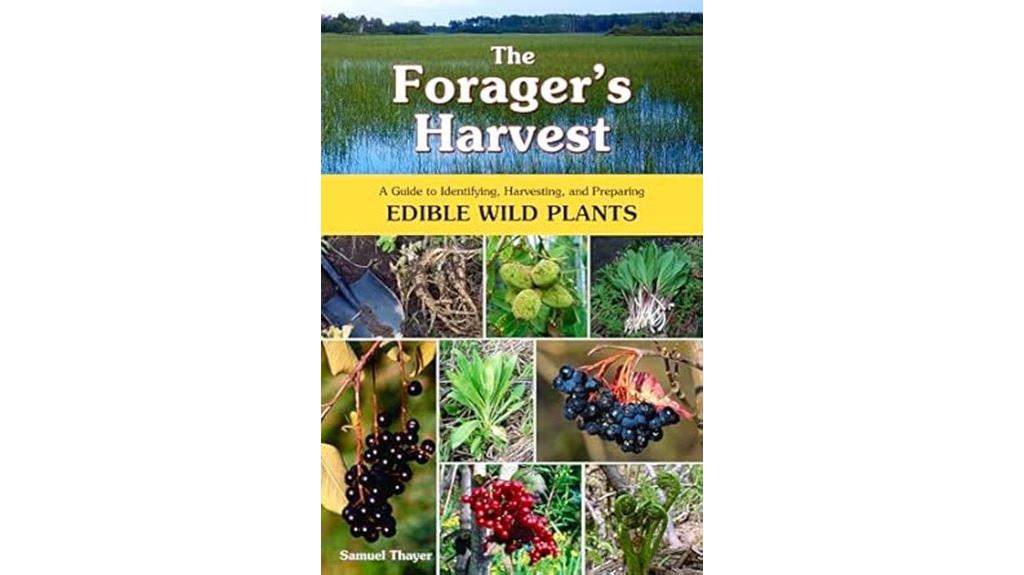
Designed specifically for beginners, “The Forager’s Harvest” stands out as an ideal guide for those new to wild plant foraging who want clear, practical instructions. I appreciate how Samuel Thayer emphasizes safety, proper identification, and responsible harvesting, making it accessible without overwhelming jargon. The book’s detailed photographs and seasonal calendars help me identify plants at various growth stages and know when to harvest. I’ve used it in the field, finding it durable and easy to navigate. Thayer’s personal stories and thorough descriptions deepen my understanding, making foraging both enjoyable and educational. It’s a reliable resource that builds confidence for anyone starting their wild edible journey.
Best For: beginners and outdoor enthusiasts seeking a clear, practical guide to safe wild plant foraging with detailed photographs and seasonal insights.
Pros:
- Emphasizes safety, responsible harvesting, and proper identification for beginners
- Features high-quality photographs, seasonal calendars, and detailed descriptions to aid learning
- Durable, field-ready design with straightforward language and personal stories for engagement
Cons:
- Focuses primarily on North American plants, limiting use in other regions
- Contains fewer plant species compared to more comprehensive guides, with future volumes planned
- Slightly heavy and bulky for carrying on extended outdoor foraging trips
Peterson Field Guide to Medicinal Plants & Herbs of Eastern & Central North America
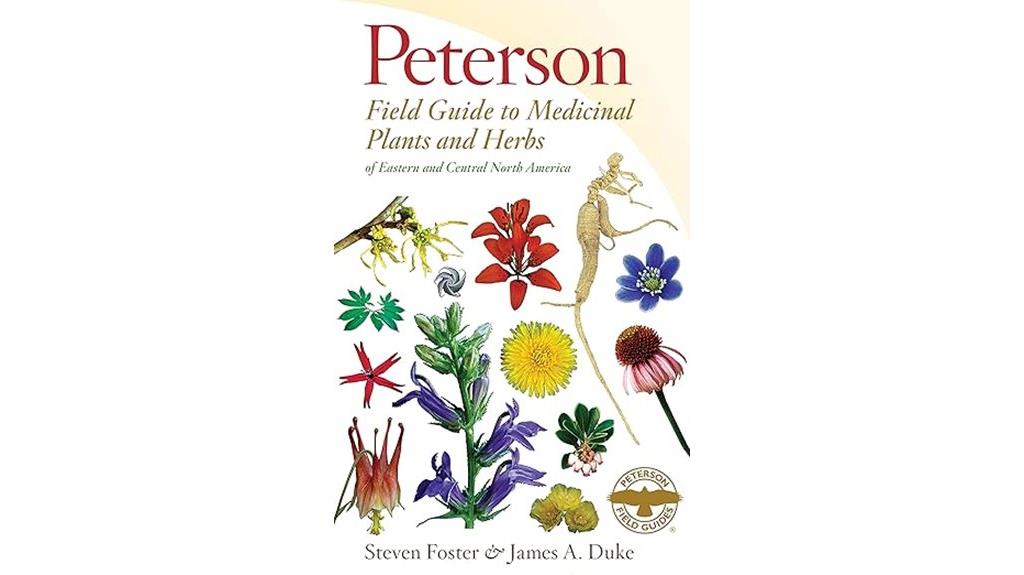
If you’re new to plant identification or want a reliable reference for safe and effective use of medicinal herbs, Peterson Field Guide to Medicinal Plants & Herbs of Eastern & Central North America is an excellent choice. It offers detailed descriptions, full-color images, and practical info on hundreds of plants, including their uses, toxins, and history. The guide is well-organized with easy navigation, making it perfect for hikers, foragers, and outdoor enthusiasts at any experience level. Its compact size ensures portability, so you can carry it on hikes and outdoor adventures. Overall, it’s a trusted resource that enhances your knowledge and confidence in identifying and using medicinal plants safely.
Best For: outdoor enthusiasts, hikers, foragers, and anyone interested in safely identifying and using medicinal plants in Eastern and Central North America.
Pros:
- Highly detailed descriptions and full-color images aid in accurate plant identification
- Compact, portable design makes it easy to carry on outdoor adventures
- User-friendly layout and organization enhance quick reference and learning
Cons:
- Some images and fonts are small, which may be difficult for casual browsing or detailed study
- Quality of pictures could be improved for clearer recognition in certain cases
- Limited to plants found in Eastern and Central North America, not suitable for those outside this region
Edible Wild Plants Guide for North America
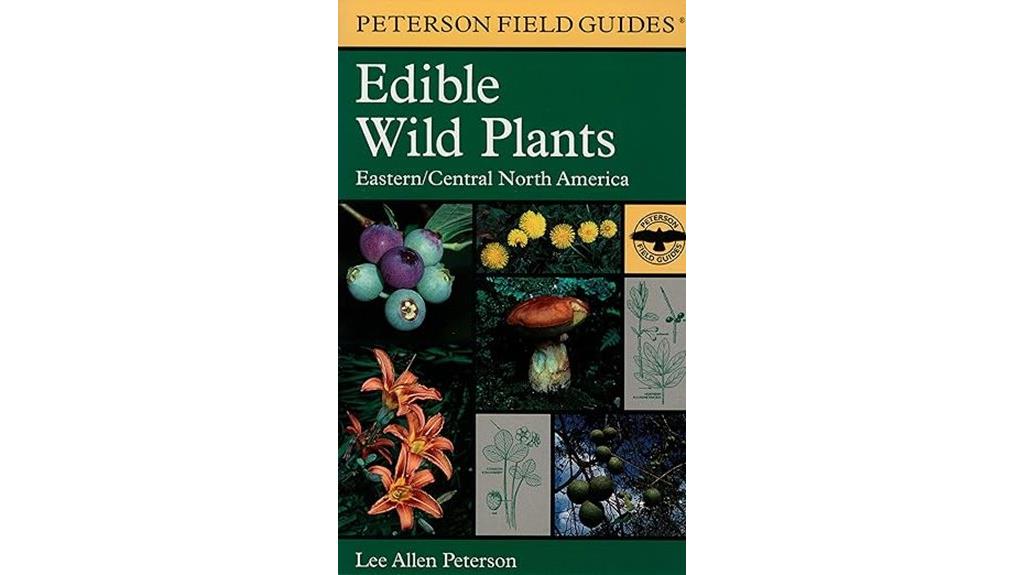
If you’re new to wild plant identification and want a practical, easy-to-carry resource, the Edible Wild Plants Guide for North America is an excellent choice. It helps you identify and learn about various edible plants in the field, perfect for planned foraging trips. The guide features detailed descriptions, vivid photographs, and key identification tips, emphasizing cautious harvesting and awareness of toxic look-alikes like poison ivy or oak. Compact and waterproof, it’s ideal for outdoor use, whether backpacking or camping. Remember, it’s a learning tool—supplement your knowledge with online resources and hands-on practice to ensure safe foraging.
Best For: Beginners and outdoor enthusiasts seeking a practical, portable guide to safely identify and learn about edible wild plants in North America.
Pros:
- Compact, waterproof design ideal for field use during outdoor activities
- Detailed descriptions and vivid photographs enhance plant identification
- Emphasizes safety with warnings about toxic look-alikes like poison ivy and oak
Cons:
- Black-and-white images may make quick identification of plant features difficult
- Some popular regional plants, such as Lemon Balm, may be missing or underrepresented
- Should not be relied upon solely for survival; requires supplementary research and hands-on practice
National Audubon Society Field Guide to North American Mushrooms

The *National Audubon Society Field Guide to North American Mushrooms* is an excellent choice for outdoor enthusiasts and serious mushroom enthusiasts who want a reliable, visually guided resource. With 762 well-photographed images covering 703 species, it offers detailed descriptions, habitat info, and edibility notes. The guide groups mushrooms by shape into 14 classes, making identification easier in the field. While sturdy and portable, it’s better suited for backpacks than pockets. Though it doesn’t cover every species exhaustively, it’s ideal for casual foraging, learning, and identifying common mushrooms. I recommend supplementing it with specialized guides for more in-depth research or edible mushroom hunting.
Best For: outdoor enthusiasts, casual mushroom foragers, and serious hobbyists seeking a comprehensive visual guide for identifying North American mushrooms.
Pros:
- Highly detailed, well-photographed images covering 703 mushroom species for easy identification.
- Organized by shape into 14 classes, facilitating quick and accurate field recognition.
- Durable, sturdy cover with extensive descriptions and habitat information, making it a reliable field resource.
Cons:
- Bulky and not pocket-sized, less convenient for quick, on-the-go foraging.
- Limited to one image per species, which may hinder detailed identification of variations.
- Lacks exhaustive detail for advanced mycological research and specific edibility or medicinal data.
The Complete Guide to Edible Wild Plants

For beginners interested in exploring wild edibles, The Complete Guide to Edible Wild Plants offers straightforward identification tips and essential safety precautions. I appreciate its focus on easy-to-recognize plants, including potentially dangerous species, making it a practical starting point. The guide covers a wide range of ecosystems—from Arctic to desert—and provides basic plant anatomy to help with identification. It also shares useful info on nutrition, raw versus cooked consumption, and fun facts. While the photos can be blurry or low quality, the book’s compact size makes it handy for hikes. Overall, it’s a helpful resource, though better images and regional info would improve usability.
Best For: beginners seeking a practical, portable guide to edible wild plants with basic identification and safety tips.
Pros:
- Easy-to-understand information suitable for newcomers
- Compact size ideal for outdoor use and hikes
- Covers a wide range of ecosystems and includes safety precautions
Cons:
- Photos are often blurry or of low quality, hindering identification
- Lacks detailed botanical or regional classification
- Organization may require prior knowledge of plant names to locate species quickly
Mushrooming Without Fear: Beginner’s Guide to Safe and Delicious Mushrooms
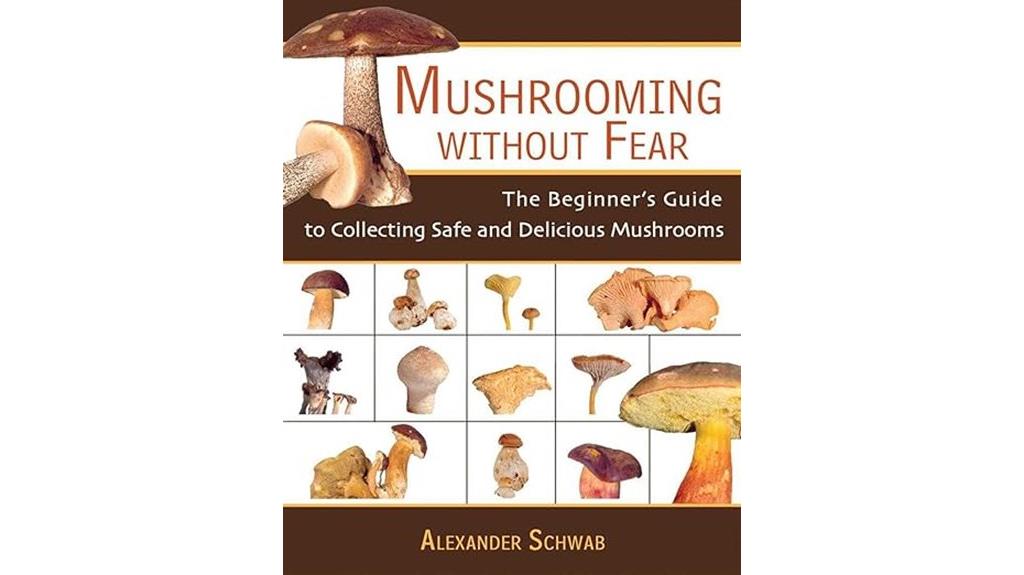
Mushrooming Without Fear stands out as an ideal guide for beginners who want to start foraging safely and confidently. It offers clear, step-by-step instructions, colorful photos, and practical safety rules that help novices identify edible mushrooms, mostly in the US, like boletes and chanterelles. The book emphasizes avoiding gilled mushrooms initially, reducing poisoning risks. Its concise format makes it easy to read quickly, perfect for field use. Though limited in scope, it provides a solid foundation to build confidence. Overall, it’s a practical, approachable tool that encourages safe mushroom harvesting and culinary exploration, especially for those just starting out.
Best For: beginners and novice foragers seeking a safe, straightforward introduction to mushroom identification and harvesting in the US.
Pros:
- Highly visual with hundreds of clear, colorful photographs that aid quick identification
- Emphasizes safety with practical rules, especially avoiding gilled mushrooms initially to prevent poisoning
- Compact and easy to read, making it ideal for quick reference in the field or during hikes
Cons:
- Limited scope, covering only about 12-15 mushroom types, which may require additional resources for more variety
- Simplifies mushroom identification, not suitable for experienced foragers or those needing detailed taxonomy
- Lacks coverage of some popular edible mushrooms like morels, requiring supplementary guides for comprehensive foraging
Fearless Foraging Guide to Edible Wild Plants
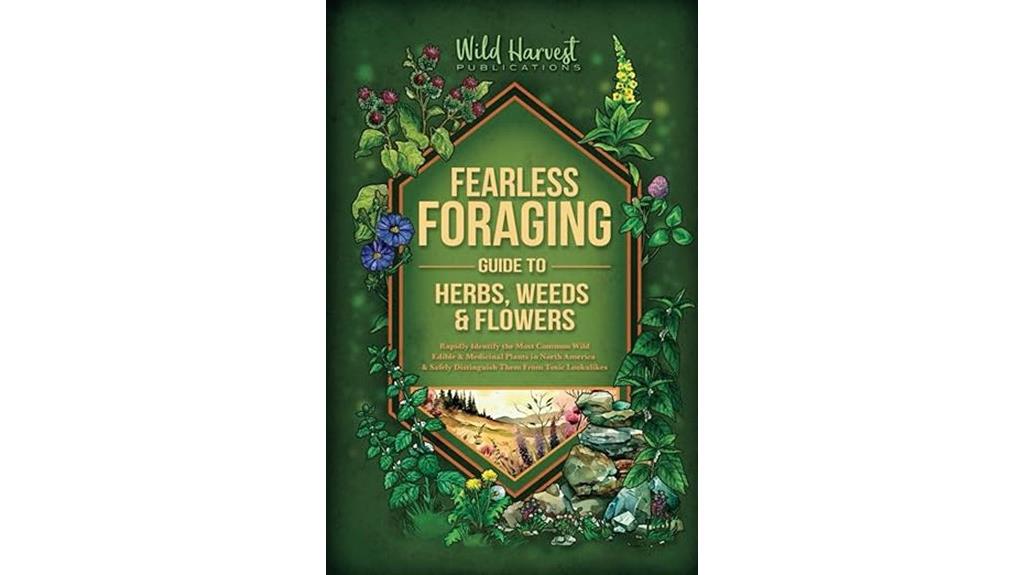
If you’re enthusiastic to explore wild plants safely and confidently, the “Fearless Foraging Guide to Edible Wild Plants” stands out as an excellent choice. This well-structured book offers clear, detailed descriptions of North American plants, including habitat, season, appearance, and uses. With 2-3 color photos per plant, it makes identification easier for beginners and experienced foragers alike. The guide emphasizes safety, highlighting poisonous look-alikes, toxic parts, and hazards, while offering practical tips on ethical foraging. Its positive tone and exhaustive coverage make it a dependable resource to boost your confidence and ensure a safe, enjoyable foraging experience.
Best For: beginners and experienced foragers seeking a comprehensive, safe, and visually guided resource for identifying and using North American wild edible plants.
Pros:
- Clear, detailed plant descriptions with habitat, season, and usage info
- 2-3 color photos per plant for easy identification at various growth stages
- Emphasis on safety, toxicity warnings, and ethical foraging practices
Cons:
- Lacks guidance on thorn removal techniques and plant disease symptoms
- Some users find black-and-white photos less helpful for identification
- Focuses mainly on familiar North American plants, less on desert or rare species
Foraging for Survival: Edible Wild Plants of North America

This guide is an essential resource for anyone serious about survival, offering detailed, high-quality photographs that make identifying edible wild plants straightforward. The images, produced by an on-site team, guarantee accuracy and help distinguish plants from dangerous look-alikes. It emphasizes practical knowledge, explaining which parts of plants are edible and how to prepare them safely. Designed for both beginners and experienced foragers, it includes tips on avoiding poisonous species and utilizing plants found in yards or natural environments. Its durable print and engaging presentation make it a valuable addition to any survival library, perfect for quick reference in critical situations.
Best For: survivalists, outdoor enthusiasts, and foragers seeking a comprehensive, practical guide to identifying and preparing edible wild plants in North America.
Pros:
- High-quality, detailed photographs produced on-site for accurate plant identification.
- Practical focus on safe harvesting, preparation, and avoiding poisonous look-alikes.
- Durable print and engaging presentation, suitable as a reference and coffee table book.
Cons:
- Some users desire larger images for easier identification.
- Focus primarily on North American plants, limiting applicability elsewhere.
- The book emphasizes survival situations, which may be less relevant for casual foraging enthusiasts.
National Geographic Field Guide to Trees of North America
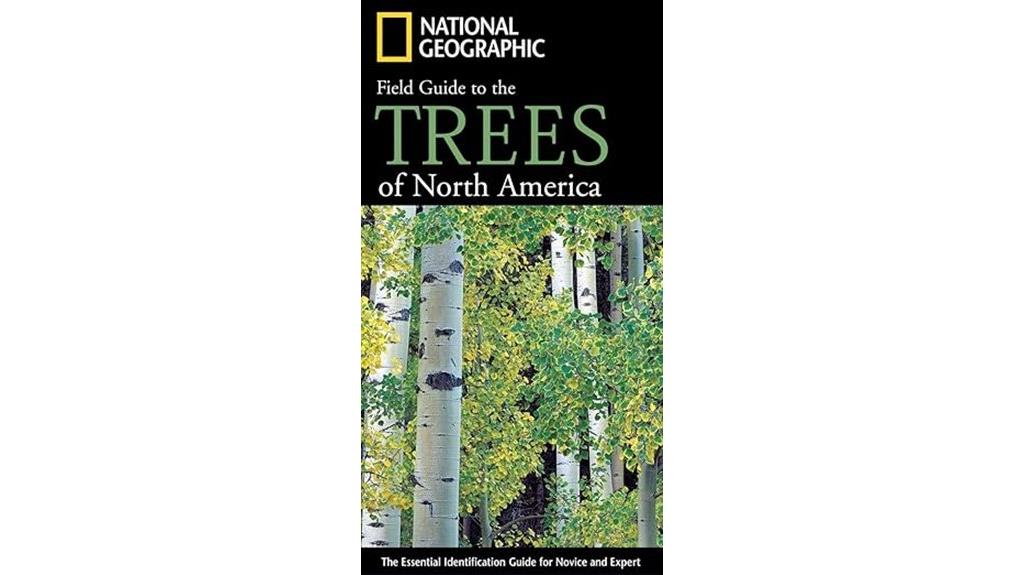
The National Geographic Field Guide to Trees of North America stands out as an essential tool for outdoor enthusiasts and beginners alike who want quick, reliable identification of trees in the field. Its compact size makes it perfect for backpacking, fitting easily into a pocket or small pack. The guide includes over 260 pages of high-quality, color drawings that simplify identification, with descriptions highlighting bark, leaves, and other features. While some images lack detail or are inconsistent, the clear symbols and straightforward layout make it user-friendly. It’s ideal for hikes, outdoor exploration, or casual park visits, especially for those comfortable with metric units.
Best For: outdoor enthusiasts, beginners, and anyone interested in quick, reliable tree identification during hikes or casual nature walks.
Pros:
- Compact and lightweight design ideal for backpacking and field use
- High-quality color drawings that enhance easy identification of trees
- User-friendly layout with clear symbols and descriptions
Cons:
- Some images may lack detail or be inconsistent across pages
- Uses metric units, which may be less convenient for users accustomed to imperial measurements
- Occasional missing pages can affect the completeness of the guide
Common Poisonous Plants and Mushrooms of North America
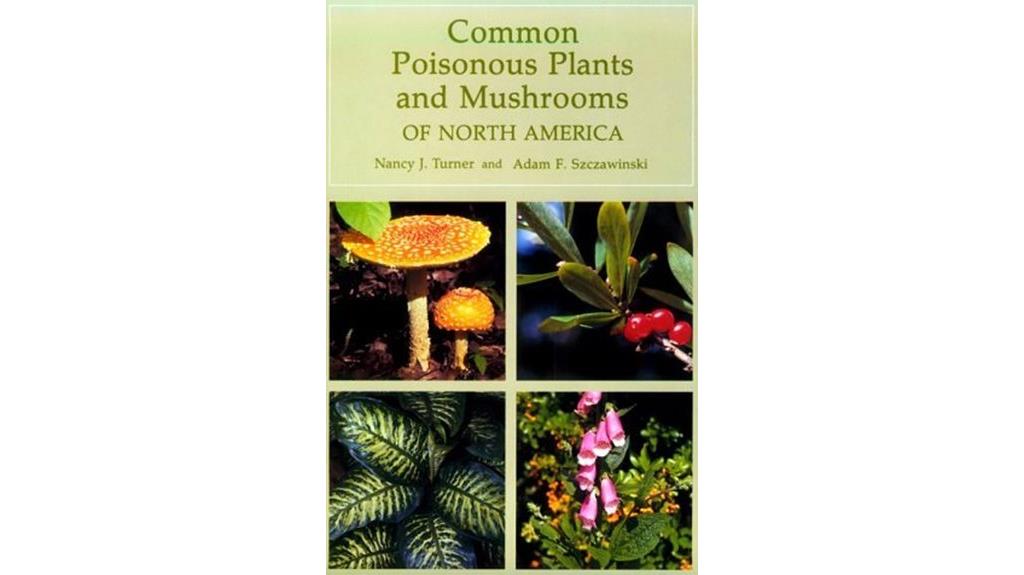
For anyone interested in safely foraging or exploring North American flora, the “Foraging Guides in North America” stands out as an essential resource. It offers extensive coverage of poisonous plants and mushrooms, with detailed descriptions, toxicology info, treatment options, and vibrant photographs for easy identification. While some suggest adding geographic organization and close-up images, the guide remains invaluable for recognizing hazards. Its approachable language makes it useful for gardeners, hikers, and parents alike. The book’s visual appeal and practical insights help prevent poisoning and deepen understanding of plant toxins, making it a must-have for anyone venturing into wild edibles.
Best For: outdoor enthusiasts, gardeners, parents, and educators seeking a comprehensive, visually-rich guide to identifying and understanding poisonous plants and mushrooms in North America.
Pros:
- Extensive coverage with detailed descriptions, toxicology info, and treatment options.
- High-quality, vibrant photographs that aid in accurate identification.
- User-friendly language making it accessible for novices and professionals alike.
Cons:
- Size and weight may limit portability for field use.
- Some users desire more detailed close-up images of plant features like leaves and flowers.
- The plant list may be somewhat limited regarding adult poisoning risks, focusing more on accidental ingestion and children.
National Audubon Society Field Guide to North American Mushrooms
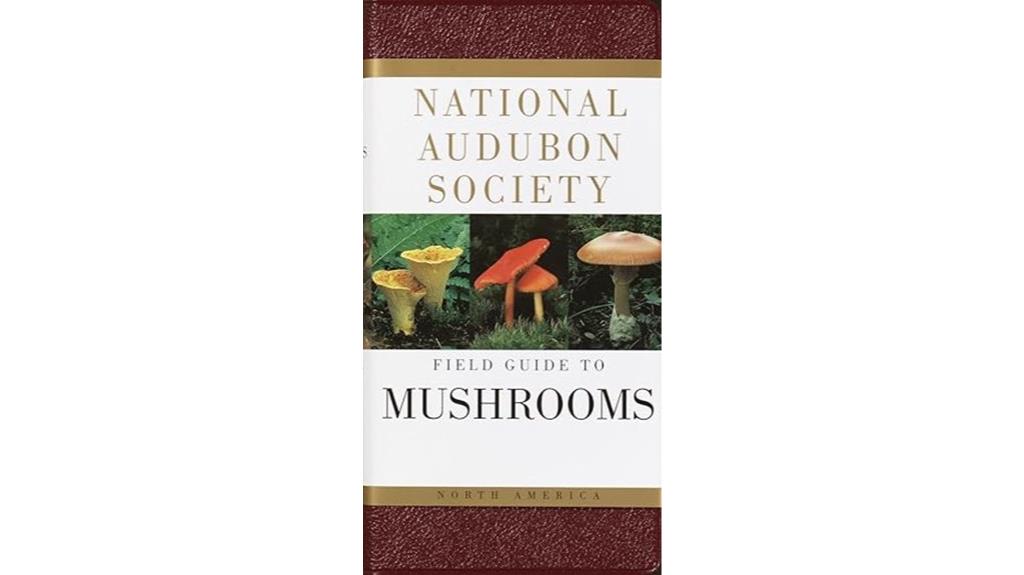
If you’re an outdoor enthusiast or a serious mushroom hunter, the *National Audubon Society Field Guide to North American Mushrooms* stands out as an essential resource. It features 762 high-quality images of more than 700 species, with detailed descriptions, habitat info, and edibility notes. Organized by shape into 14 classes, it makes identification easier in the field. Though somewhat bulky, it’s perfect for backpacks and car trips. While it’s not exhaustive or ideal as a sole resource, it’s invaluable for casual foraging, learning, and recognizing common mushrooms. Its durable design and all-encompassing content make it a trusted guide for both beginners and experienced foragers.
Best For: outdoor enthusiasts, hobbyists, and serious mushroom foragers seeking a comprehensive and reliable field guide for identifying North American mushrooms.
Pros:
- Extensive collection of 762 high-quality, well-photographed images covering over 700 species.
- Organized by shape into 14 classes, making field identification more straightforward.
- Durable, high-quality design suitable for outdoor use and learning in the field.
Cons:
- Bulky size makes it less convenient for pocket carry during foraging trips.
- Lacks detailed variations and multiple images per species, which can limit precise identification.
- Not a comprehensive or sole resource for edible mushroom foraging, requiring supplementary guides for safety.
A Field Guide to Mushrooms of the Carolinas (Southern Gateways Guides)
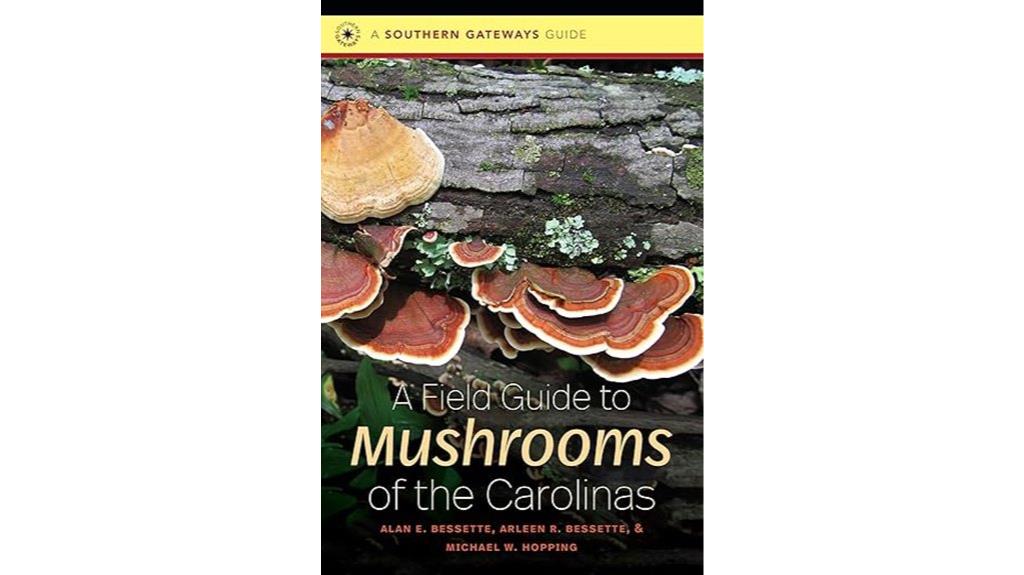
A Field Guide to Mushrooms of the Carolinas stands out as the ideal resource for mushroom enthusiasts and foragers in the southeastern United States seeking detailed regional identification tools. This guide offers nearly 400 pages with about 800 species descriptions and photos, covering a broad range of macrofungi from Virginia to Alabama. Its clear photographs and organized taxonomy make identification easier, especially for regional species. While it has some minor flaws, like small images and occasional errors, it remains one of the most *extensive* guides for the Carolinas. Whether you’re a hobbyist or a professional, this book is a valuable tool for *accessing* the region’s diverse mushroom treasures.
Best For: amateur mushroom foragers and regional mycologists seeking a comprehensive guide to southeastern U.S. macrofungi.
Pros:
- Extensive coverage with approximately 800 species descriptions and photos
- Clear photographs and organized taxonomy facilitate accurate identification
- Valuable regional focus from Virginia to Alabama with detailed regional species info
Cons:
- Small images may be less suitable for quick field identification
- Occasional errors and inconsistent formatting suggest rushed editing
- Lacks a visual glossary of mushroom anatomy and more detailed descriptive entries
Factors to Consider When Choosing North American Foraging Guides
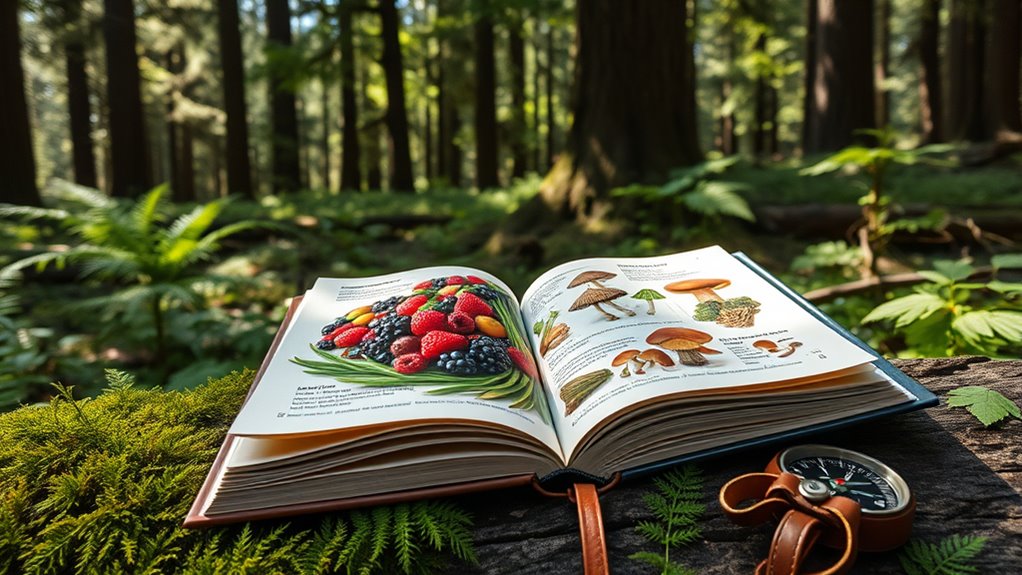
When selecting a foraging guide, I consider how well it covers my specific region since accurate information varies across North America. I also look for clear identification tips, helpful visuals, and safety details to avoid toxic look-alikes. ultimately, I prefer guides that are easy to use, so I can quickly access the info I need in the field.
Regional Coverage Importance
Choosing a foraging guide with strong regional coverage is essential because plant species can vary greatly across North America. A guide tailored to your specific area provides detailed information on local habitat, seasonal availability, and growth patterns, which are vital for safe and successful foraging. Broadly distributed guides might lack the depth needed for regional species, increasing the risk of misidentification and safety concerns. Regional guides often include local common names, helping foragers connect with community-specific terminology and understand the plants they’re most likely to encounter. By focusing on your region, a guide helps you develop practical knowledge and confidence, ensuring you’re identifying edible plants accurately and responsibly. This targeted approach makes foraging safer, more effective, and more enjoyable.
Identification Clarity Levels
Clear identification is essential when selecting a foraging guide, and high-quality visuals play a key role in achieving this. Well-crafted photos or detailed illustrations that accurately show key plant features help users distinguish similar species more easily. Guides that display multiple growth stages, parts like leaves, flowers, and fruits, and look-alike species improve recognition accuracy. Color photographs often make it easier to differentiate plants compared to black-and-white drawings. Descriptive text emphasizing distinctive traits—such as leaf shape, bark texture, or fruiting bodies—further clarifies identification. A well-organized guide that groups species by visual traits or habitat, with clear labels and indexes, allows for quicker, more confident recognition. Together, these elements markedly enhance the guide’s identification clarity.
Visuals and Photos
High-quality visuals are the backbone of effective foraging guides, especially for wild plants and mushrooms in North America. Clear, well-lit photos and detailed illustrations are essential for accurate identification in the field. Multiple images showing different plant parts at various growth stages help prevent misidentification and potential poisoning. Visual aids organized by shape, color, or key features make the identification process more straightforward and learning more efficient. Including close-ups of identifying characteristics enhances recognition and confirms correct identification. Additionally, comparative images of toxic look-alikes alongside edible options are invaluable for distinguishing safe plants from dangerous ones. Overall, exhaustive, high-quality visuals not only improve accuracy but also boost confidence when foraging in the wild.
Safety and Toxicity Info
Ever wonder how to stay safe while foraging in North America? A good guide should include detailed info on poisonous plants and mushrooms, highlighting look-alikes and toxic parts to prevent accidental poisoning. Safety-focused guides often feature clear warnings, identification tips, and photographs of hazardous species, making it easier to distinguish dangerous plants from safe ones. Many guides also provide treatment options and safety precautions, especially for children or beginners who might be less familiar with plant toxins. Visual aids like color photos and illustrations are essential for quick recognition in the field. When choosing a guide, look for one that offers a balanced mix of extensive toxicity information and practical identification tips—this helps ensure you can forage confidently and safely.
Ease of Use
When choosing a foraging guide for North America, ease of use is crucial to guarantee a safe and successful experience. A good guide features clear, straightforward language and well-organized sections that make quick identification in the field easier. Visual aids like high-quality photos or detailed illustrations should be prominently displayed and labeled for rapid recognition of plants and fungi. The layout needs logical categorization—by plant type, seasonality, or habitat—to help navigate information efficiently during outdoor excursions. Concise descriptions that highlight key features such as shape, size, habitat, and markings make identification accessible, especially for beginners. Practical tools like checklists, symbols, or flowcharts also boost usability, enabling confident, rapid decisions while foraging.
Content Depth and Scope
Choosing a foraging guide that balances detail with usability depends heavily on its content depth and scope. I look for guides that cover a wide range of plants, fungi, and wild foods relevant to North America, rather than just focusing on a specific region. The guide should provide detailed identification info—such as plant parts, growth stages, habitat, and preparation—to match my experience level. It’s also essential that safety warnings and information on toxic look-alikes are included, ensuring responsible foraging. I prefer guides that encompass edible, medicinal, and culinary uses, offering a holistic knowledge base. Organization matters too—quick references by season, habitat, or plant type make field identification faster and more practical. A well-rounded scope enhances both confidence and safety in foraging adventures.
Portability and Size
How important is portability when selecting a foraging guide for North American wild foods? Very, I’d say. A lightweight guide, ideally under a pound, helps prevent fatigue on long outdoor trips. Compact sizes, like 4 x 6 inches or smaller, fit easily into pockets or backpacks for quick access. Spiral or flex-bound formats are best, as they resist tearing and make flipping pages easy in the field. Waterproof or water-resistant materials are vital, protecting your guide from rain, mud, and other elements. The overall thickness should be just enough to include detailed illustrations and key info without being bulky. When a guide balances portability with extensive content, it becomes a reliable, convenient companion for your wild food adventures.
Expert vs. Beginner Focus
Selecting the right foraging guide depends heavily on your experience level, as beginner and expert guides serve different needs. Beginner guides focus on simple language, basic identification tips, and a limited range of common edible plants, emphasizing safety warnings to prevent misidentification. They usually feature clear illustrations or photos optimized for quick recognition and are designed to be portable and easy to navigate. In contrast, expert guides include detailed taxonomy, advanced identification techniques, and cover a broader spectrum of species, including toxic look-alikes. They often contain microscopic images or technical drawings essential for precise identification. While beginner guides prioritize accessibility and safety, expert guides cater to seasoned foragers seeking exhaustive, in-depth knowledge for accurate identification and advanced foraging pursuits.
Frequently Asked Questions
How Do Foraging Guides Address Regional Seasonal Variations?
Foraging guides address regional seasonal variations by providing detailed charts and timelines specific to each area. I find they emphasize understanding local climate patterns, plant cycles, and peak harvest times. These guides often include seasonal illustrations and tips on recognizing when certain edibles are ripe. By following these, I can confidently forage at the right time and avoid confusing plants that look similar but are toxic.
Are There Digital or App-Based Foraging Guides Available?
Are there digital or app-based foraging guides available? Absolutely! I’ve found several great apps that help identify wild edibles, track seasonal changes, and provide detailed descriptions. Have you tried using them in the field? These apps can be incredibly handy, especially when you’re unsure of a plant’s identity. They’re perfect for both beginners and seasoned foragers, making wild harvesting safer and more accessible right from your phone.
How Do Guides Differentiate Between Edible and Toxic Plants?
Guides differentiate between edible and toxic plants by providing detailed descriptions, photographs, and key identifying features. I always look for information on plant parts, seasons, and habitats, and I double-check with multiple sources. Trusting reputable guides is essential, as they highlight dangerous look-alikes and toxicity signs. I also recommend learning from experienced foragers or local experts to avoid mistakes and guarantee safety while foraging.
Do Foraging Guides Include Sustainable Harvesting Practices?
Yes, many foraging guides include sustainable harvesting practices. I find them helpful because they teach me how to gather wild edibles responsibly, ensuring I don’t damage plant populations or ecosystems. These tips often cover minimal impact techniques, proper plant identification, and respecting local regulations. By following these guidelines, I feel confident I’m foraging ethically, helping preserve wild foods for future generations while enjoying the bounty of nature safely.
Are There Guides Tailored for Urban Foraging Environments?
Absolutely, there are guides tailored for urban foraging, turning concrete jungles into edible wonderlands. I’ve used these guides to spot wild greens peeking between pavement cracks and find edible flowers in park flower beds. They’re packed with tips for traversing city landscapes safely and sustainably. So, next time you’re stuck in traffic, remember—your urban jungle might just be a treasure trove waiting to be foraged.
Conclusion
If you’re ready to unfasten North America’s wild bounty, these guides are your first step. But beware—nature holds surprises at every turn. With each foraging adventure, you’ll gain confidence and uncover secrets hidden beneath the leaves. Are you prepared to venture deeper, to discover the wild edibles waiting just beyond sight? Grab one of these guides, and let’s see where the wilds take us next—there’s so much more to explore than you might imagine.
